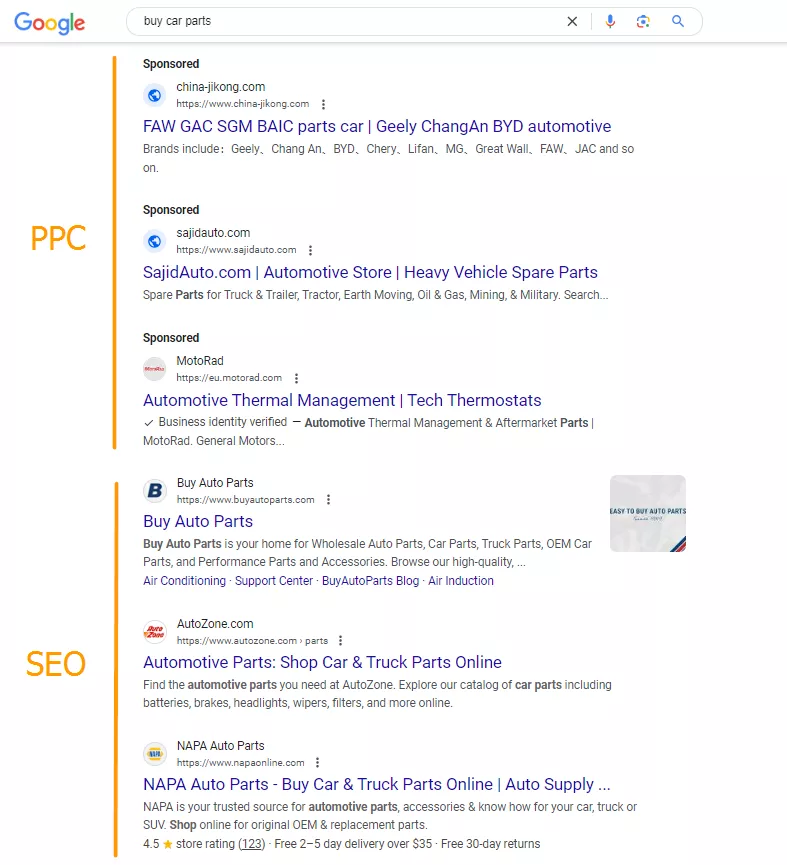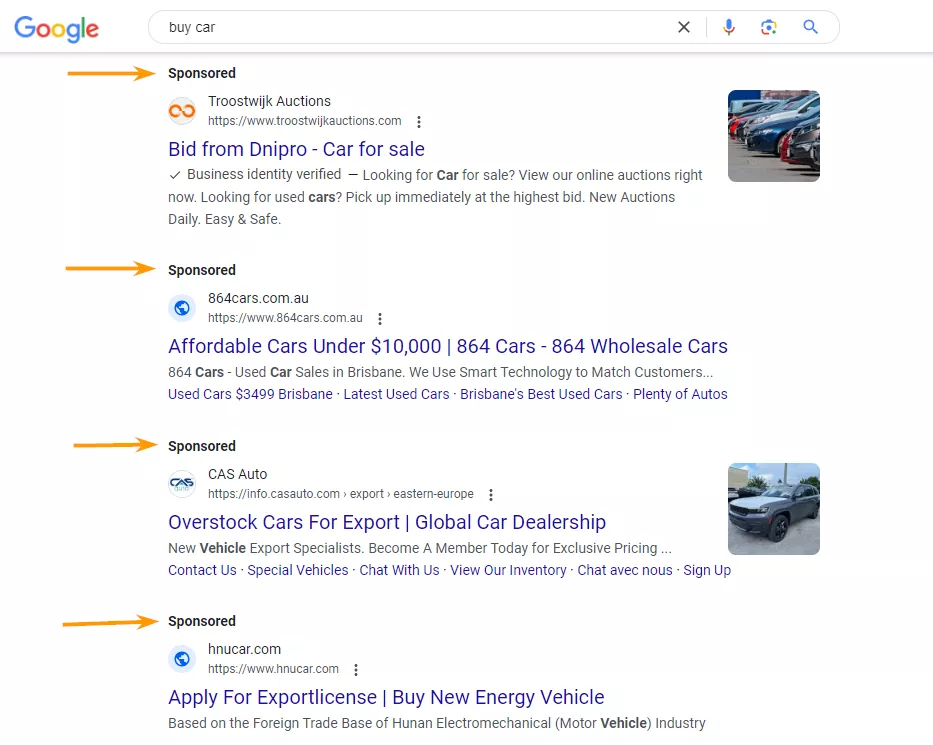“What is SEO and contextual advertising?” is a common search query in search engines. It is common to search for information about what SEM is along with these concepts.
If you want to understand the topic and determine which method of promotion is suitable for your site – SEO or PPC, and whether you should pay attention to SEM, this article is for you.
In the article, I will tell you about the features of all three promotion methods and prepare a tool with the help of which you will find the best solution for you.
- Features of SEO
- When to choose SEO?
- Features of PPC
- Who is РРС suitable for?
- What is SEM?
- Combined approach: SEO + PPC = SEM
- The difference between SEO, PPC, and SEM: a comparison chart
Features of SEO
Search Engine Optimization (SEO) includes methods of optimizing various site parameters to improve its ranking by search engines (SE).
The main task of SEO is to make the site pages meet the search engine’s requirements and be displayed as high as possible in the search results.
Sites promoted by search engines make up the majority of search results. On the search results page, they are located below the block of PPC-promoted pages and marked as sponsored.
Sometimes, there may be two or three PPC blocks on the page, the first one necessarily at the top.
This means that even if your site is a leader in SEO promotion, it will not always be in the first line of the output – usually, the first positions are for contextual advertising.
Dive into our glossary for key SEO definitions to boost your expertise!
Advantages of SEO
- Long-term results. If you stop investing in the SEO channel tomorrow, there will be no sharp drop in traffic. The result is maintained for a long time, and all the work done will positively affect the site ranking.
- Does not require significant financial investment in a short period. SEO is not the fastest option for promotion, so financial investments are systematically distributed over time.
- Performance stability. If your site is in the leading positions, the probability of its downgrading is insignificant.
Exceptions can be:
- Google updates. If the content no longer meets the new requirements of the search engine, the site may be sanctioned, which will lead to a decrease in its position in the search results or removal from the index;
- Increased competition. If your competitors are more active than you in building link mass, publishing new and relevant content, and improving the technical characteristics of the site, your position will soon drop.
- Increased trust. Our experience shows that snippets (a brief representation of the site in search results) without the Sponsored mark cause a more trusting attitude of some users.
SEO is ideal for businesses looking for sustainable growth over time and wanting to build long-term visibility in search results. For example, if you sell handmade products or vintage items, specialized Etsy SEO Services can help you rank higher in Etsy search and drive more qualified traffic.
These advantages make SEO favorable for steady site growth and increased user trust.
Disadvantages of SEO
Search engine optimization has a number of disadvantages that you should consider before you start:
- Long time to see the first results. On average, not before six months.
- Possible penalties from search engines. Unconsidered and radical actions in the field of SEO, such as the use of forbidden methods (“black” or “gray” SEO), will lead to the imposition of penalties on the site and its pessimization (lowering of positions) in the search results.
Search engine algorithms are constantly changing and improving to ensure that only high-quality pages most relevant to user queries are ranked at the top of the output. Therefore, SEO is an important channel that should be constantly addressed.
Look for new approaches and working strategies for different types of sites and different niches, analyze competitors and their keys, and constantly optimize the site, even if it is designed to the fullest.
When should you choose SEO?
SEO for website promotion is suitable for you if:
- You do not expect immediate results.
- You need to attract users from the organic (free) channel.
- You are still thinking about creating a website — in that case, SEO at the website development stage is crucial to avoid technical debt and ensure search readiness from day one.
- Your site is subject to advertising restrictions – medicine, alcohol, gambling (casino), cryptocurrency exchanges, some substances (Botox), adult stores, etc.
- Your site is in a field with high cash flow and strong competition, such as real estate or insurance.
Search engine optimization is suitable, for example, for promoting sites that sell or provide services, as well as for information and news platforms. See more case studies of the effective use of SEO.
However, SEO does not work for one-page sites and sites with several pages. There should be at least 10 to 20 pages on a resource for optimization, all because there is not enough content on such sites.
It will not be possible to cover a sufficient number of keywords and make the linking so that targeted requests can be placed on different landing pages. It will be challenging to optimize the site speed if too much information is placed on one page.
Features of PPC
Contextual advertising, or PPC (Pay Per Click), is an online advertising in which the website owner pays the Google search engine for clicks on ads when a user visits the website. The sites that are advertised using PPC methods are as follows:
PPC advertising is an effective tool to quickly attract traffic and increase your site’s visibility in search engine results. I suggest you read Netpeak Agencies Group’s successful PPC case studies.
Advantages of PPC
PPC has a number of compelling benefits:
- Quick, tangible results. Sometimes one day is enough. There are strategies that need a certain amount of time (from two weeks) to reach stable indicators.
- Suitable for advertising in the early stages of site development. Since contextual advertising does not place high demands on the advertised sites, it is well-suited for young projects.
- Works well when promoting seasonal and non-seasonal products. Launching advertising does not require extensive advance preparation. PPC is suitable for goods/services with seasonal demand, such as fur coats and sheepskin coats, hot tours, as well as for goods without pronounced seasonality, such as diapers and wet wipes.
- It is a convenient tool for testing new products/services. There’s no need to prepare a site in detail or spend money and time on preliminary work. That’s why PPC is also suitable for testing product sales within a niche.
- Geotargeting. The ability to accurately determine the audience to which ads are shown. You can customize geotargeting down to the street level.
Another non-obvious advantage of PPC advertising is that you do not need to consider many nuances and customize the entire site. Of course, if the site works poorly, the user will unlikely stay there for long. However, the resource does not have to be perfect in terms of various requirements of Google, as in the case of SEO.
Check out our glossary for key online advertising definitions to enhance your marketing knowledge!
Disadvantages of PPC
Despite the numerical advantages, PPC also has certain disadvantages that should be taken into account when choosing this strategy:
- High risk of wasting the budget. If the pre-analysis and ad settings are not correct, contextual advertising will not produce results.
- Restrictions due to the subject matter of the advertised site. Many niches are subject to strict rules, such as medicine, gambling, etc.
- Low level of trust. There are users who do not trust the sites in the ad block.
- Constant financial costs. If there is no funding, the result will disappear immediately – the advertisement will no longer appear in the search results.
If a person visits your site, there is no guarantee that he will buy your service or product.
Who is РРС suitable for?
You should opt for it if:
- You have a clear understanding of who your audience is.
- You want to see results in a short period of time.
- You are launching a new product.
- You want to create a positive and memorable impression of your brand with minimal time investment.
- Your service/product is in seasonal demand.
- You have a business card website.
Contextual advertising is suitable for the promotion of online stores, SaaS projects, and the development of agencies providing various services.
What is SEM?
SEM (Search Engine Marketing) is a digital marketing strategy that aims to increase a website’s visibility in search engine results pages (SERPs).
There are two opposing approaches:
- One argues that only paid marketing strategies belong to SEM, which means SEM=PPC.
- The other approach says that SEM integrates organic and paid promotion methods or SEM=SEO+PPC.
If you’re interested in the first approach, read on:
I will stick to the second option and talk about it from that point of view.
SEM involves using various strategies and tactics to attract the target audience and increase conversions. These include analyzing users’ search queries, optimizing content and site structure, and developing effective advertising campaigns.
Key elements of SEM:
- Keyword analysis. Research and selection of relevant keywords for promotion.
- Content optimization. Creating content relevant to users’ search queries.
- Advertising campaign management. Planning and launching advertising campaigns to increase site visibility and attract traffic. In particular, with the help of Google Ads.
- Analytics and reporting. Continuous monitoring and analysis of results to improve strategy and results.
- Adaptation to behavioral patterns. Considering user interests and behavior for more accurate targeting and increased conversions.
Using SEM, brands can increase their visibility and effectively engage with their target audience to drive conversions.
Advantages of SEM
As a synthesis of two promotion methods – SEO and PPC, SEM has a number of advantages:
- There are paid and free channels of attraction. Therefore, the traffic grows noticeably.
- SEM uses SEO and PPC tools, so it is possible to achieve simultaneous results quickly.
- It helps to increase the recognizability of the site due to its growth in prominence, as well as to improve the site’s position and increase its trustworthiness (percentage of user trust).
Promotion with SEM allows you to act comprehensively, considering the specific situation.
Disadvantages of SEM
When choosing SEM for promotion, consider the following drawbacks:
- Combined approach. This means the work of specialists from two spheres, using various tools for analysis, debugging the site, setting up advertising, etc. Which is quite expensive.
- Different advertising strategies require constant control, monitoring, and analysis.
- Because of the complex impact on all indicators of the site is more difficult to track which tool was more effective and payback.
Weighing all the pros and cons will make it easier to make an informed decision.
Combined approach: SEO + PPC = SEM
If you’re interested in monopolizing the search engine rankings, SEM is a good fit for you. It is essentially a combination of search engine optimization and contextual advertising tools. As well as SERM (Search Engine Reputation Management) and SMM (Social Media Marketing) methods.
SEM specializes in attracting paid and organic traffic to:
- Improve website visibility. The site will appear in organic and PPC blocks.
- Increase brand awareness. The target audience will be exposed to brand mentions more frequently, building trust and loyalty.
- Increase reach. In addition to SEO and PPC, SEM attracts new users from social networks.
- Increase conversions. SEM focuses on attracting customers who are ready to buy, which increases sales and profits.
- Increase traffic. Increase traffic through paid advertising and improve search rankings.
PPC and SEO have a significant combined result. PPC immediately attracts the target audience to the site, increasing its visibility, traffic, and brand recognition. If you do not have the funds for long-term promotion, you can order a one-time SEO audit.
The difference between SEO, PPC, and SEM: a comparison chart
It is impossible to say what is better – SEO, contextual advertising, or SEM. I have compared their main parameters in the table:
|
Parameter |
SEO |
PPC |
SEM |
|
Time frame to achieve visible results |
Relatively slow (2 to 6 months) |
Fast (from 24 hours) |
There are quick and relatively slow results |
|
Costs |
Moderate amounts over a long period |
Large amounts over a short period |
Larger amounts over the life of the service, but a more efficient approach |
|
Maintenance of long-lasting effects |
Yes |
No |
Yes |
|
Need for specialized services |
Yes |
Yes |
Yes, need specialized services in various areas |
|
User confidence |
Quite high |
Not always high |
High |
|
Need to implement site changes |
Yes |
In most cases, having adequate and up-to-date information is sufficient |
Yes |
|
Focus on a specific audience |
Limited to using keyword phrases with specific geolocation parameters |
Ability to specify detailed geotargeting |
Ability to specify detailed targeting parameters |
Before deciding whether to invest in SEO, PPC, or SEM, it’s crucial to understand your site's current optimization level. Without this insight, you risk spending on channels that don’t align with your needs. To gain that essential clarity, consider our SEO Audit Services. We’ll perform a full diagnostic of your site's strengths and weaknesses, helping you make a confident decision about whether to pursue SEO, PPC, or SEM—and where to allocate resources most effectively.
Conclusions
SEM, SEO, and PPC have their characteristics, and to make an informed and correct choice, it is necessary to:
- Understand what SEM is and why it may be needed.
- Identify the characteristics of SEO and its advantages and disadvantages.
- Understand the characteristics, advantages, and disadvantages of PPC.
- Compare the main characteristics of the three development strategies and choose which one is more suitable for your project.
You must analyze many factors to choose a channel with limited funds or SEM, a more effective and costly complex method.
If you're running a SaaS business and want a tailored approach to long-term organic growth, check out our SAAS SEO Services. They’re designed to match your product’s sales cycle, search intent, and scalability needs—ensuring SEO works hand in hand with your SaaS model.
Related Articles
How to Set Up Consent Mode in GA4 on Your Website with Google Tag Manager
Let's explore how to properly integrate consent mode in GA4, configure it for effective data collection, and at the same time comply with GDPR and other legal regulations
Display Advertising Effectiveness Analysis: A Comprehensive Approach to Measuring Its Impact
In this article, I will explain why you shouldn’t underestimate display advertising and how to analyze its impact using Google Analytics 4
Generative Engine Optimization: What Businesses Get From Ranking in SearchGPT
Companies that master SearchGPT SEO and generative engine optimization will capture high-intent traffic from users seeking direct, authoritative answers





